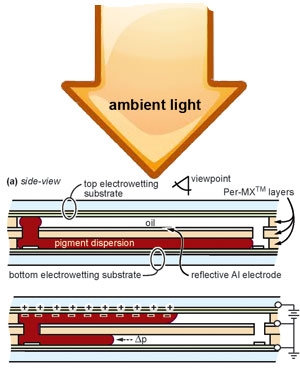Electronic Paper
November 4, 2010
There's a
recent television commercial that contrasts the electronic reading experiences of two people sitting alongside a pool in bright sunlight. One of them has a reader with a conventional
emissive or
backlighted display (OK, it's supposedly an
iPad, but no one says that). He's squinting and shading the screen as best he can to read the text on his screen. The other person has a
reflective display. She has no problem reading her display (a
Kindle). Let's face it, the more a display acts like paper, the better it is. Backlights may be good for reading in the dark, but how often do we want to read in the dark? Also, backlights and emissive displays drain a lot of battery power. That's why there's ongoing research in making
electronic paper displays that are readable in direct sunlight and maintain their image without a continuous use of power.
Most of the early electronic paper displays involved flipping something mechanically to show either a white or black face. Typically, this was done with
Janus-faced balls with black and white faces that were rotated to their final state. The major problem with this approach, and most other mechanical approaches, is the filling factor. If our balls were arranged in an optimum hexagonal array (which would make addressing of the pixels a little difficult), the ratio of the area of this circular pixel to the fixed area of the hexagonal array would be
π / (6 tan(30o) )
which is 90.7%, or about a ten-to-one
contrast ratio. This is not very good, and it's worse when a square array is used (78.5%). So, the name of the game is to devise ways to increase this ratio to get more readable displays. New research from the
Novel Devices Laboratory at the
University of Cincinnati in partnership with several industries has produced an electronic paper display that uses
electrofluidics.[1-2] The research is published in the October 4, 2010, issue of
Applied Physics Letters.[2] Partners on the display project were
Gamma Dynamics,
Dupont and
Sun Chemical; and there was also funding by the
National Science Foundation, the
Army Research Laboratory and the
Air Force Research Laboratory. It's interesting to note that this was a seven year project.

Electrofluidic display. (University of Cincinnati illustration)
As shown in the figure, changing a pixel is done by pumping a fluid from a containment chamber below the display panel to a windowed well. These fluids can be colored, so color displays are possible as well as monochrome. Movement of the fluid is by
electrowetting, a technique that uses
electrical charge to modify the
surface tension properties of interfaces. This electrowetting effect is strong. For the 450 μm
pixels used for research, there's an electromechanical pressure of 1.4 kN/m
2 that moves the fluid at about 2650 μm/sec.
Video rate, which would require a 20 msec switching time, would need 150 μm pixels at the same pumping speed. The displays maintained their state for three months without degradation. The only problem at this point is the 70% contrast, which is likely a consequence of the various optical interfaces in the device.
One stated advantage of this electrofluidic display is that it can be manufactured using the same equipment as
liquid crystal displays (LCDs). This is an important point, since an LCD manufacturing plant costs about two billion dollars, which is about the same cost of an
integrated circuit fabrication plant. The ability of these displays to show their last image without any power can make this technology useful for shelf tags in stores; and for other advertising, as the figure below shows.

![]()
References:
- M.B. Reilly, "Environmental Electronics: UC Breakthrough Promises Devices with High Speed, High Readability AND Low Power Usage," University of Cincinnati Press Release, October 4, 2010.
- S. Yang, K. Zhou, E. Kreit, and J. Heikenfeld, "High reflectivity electrofluidic pixels with zero-power grayscale operation," Appl. Phys. Lett. vol. 97, no. 14 (2010), document 143501 (3 pages).
Permanent Link to this article
Linked Keywords: Television commercial; emissive display; backlighted display; iPad; reflective display; Kindle; electronic paper displays; Janus-faced; contrast ratio; Novel Devices Laboratory; University of Cincinnati; electrofluidics; Applied Physics Letters; Gamma Dynamics; Dupont; Sun Chemical; National Science Foundation; Army Research Laboratory; Air Force Research Laboratory; Electrofluidic display; electrowetting; electrical charge; surface tension; pixels; video rate; liquid crystal displays; LCDs; integrated circuit; semiconductor fabrication plant.